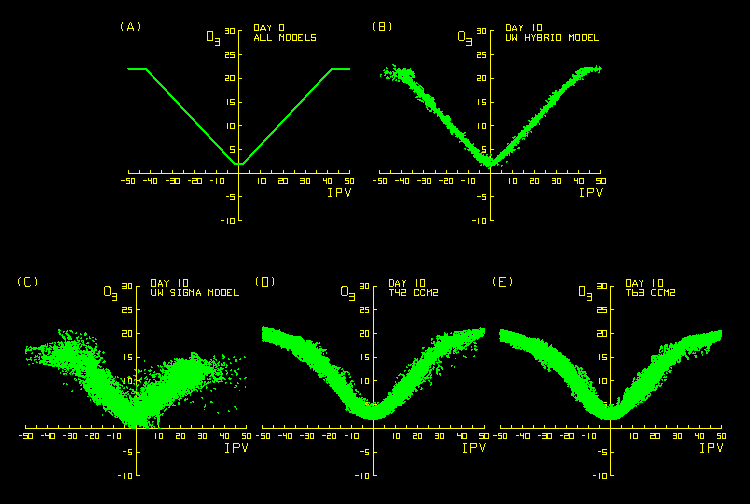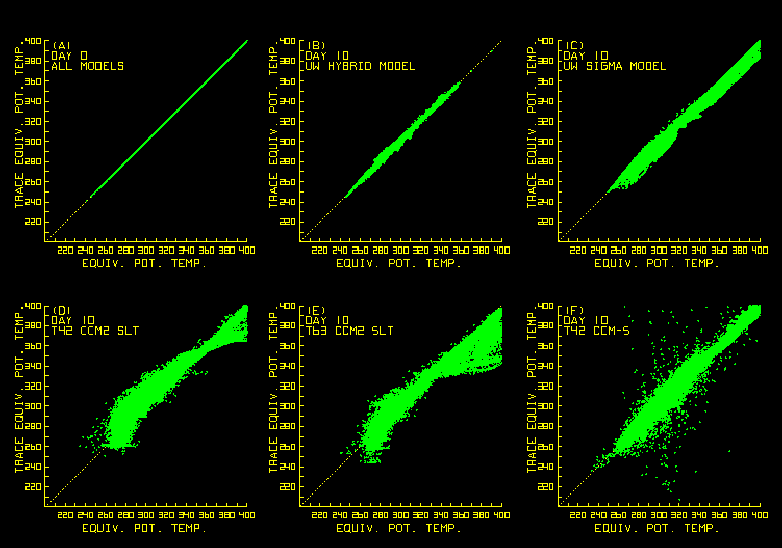
Results are presented from two numerical experiments that investigate
the relative capabilities of numerical models to accurately simulate precipitation,
water vapor transport and trace constituent transport. These experiments
provide estimates of the error which are directly related to how accurately
a model will simulate hydrologic processes resulting from the long-range
transport of water vapor and stratospheric-tropospheric exchange. The results
of these tests have wider implications, in that they examine the limits of
NWP and climate predictability by inherent limitations in the simulation
of transport processes, especially water vapor which controls cloud formation,
precipitation and the surface energy balance.
The Models and Experimental Design
The UW hybrid isentropic-sigma grid-point model (hereafter the UW hybrid model) has an average of 19.3 layers and consists of a sigma coordinate PBL 150 mb thick and an isentropic free atmosphere which extends up to 1700 K (~1-2 mb). The nominally identical UW sigma grid-point model has 18 predictive surfaces and extends from the earth's surface to a fixed upper boundary at 1 mb. The 4 layers in its lowest 150 mb closely replicate the PBL of the UW hybrid model while the remaining 14 surfaces are scaled equally by pressure over the remaining depth of the atmosphere. For this study, both UW models use 2.5° E/W by 2° N/S horizontal resolution. The time differencing, filters, borrowing, etc., in the UW models are identical and described in greater detail in Zapotocny et al. (1997a).
The NCAR Community Climate Model 2 (CCM2) is included in this comparison because of its widespread acceptance as a "state of the art" model for simulating the global climate. In this study, CCM2 is run at T42 and T63 spectral resolutions, which bracket the horizontal resolution of the UW models. CCM-S, which is identical to CCM2 except that it uses spectral transport for water vapor and other trace constituents, is run at T42 spectral resolution. The vertical resolution in all CCM versions (including CCM-S) consists of 18 layers, which is the same as the UW sigma model and slightly less than the average of 19.3 layers in the UW hybrid model. The NCAR recommended value of the diffusion coefficient (Williamson et al. 1995) is used for horizontal diffusion of the divergence, vorticity and temperature. Trace constituent transport in CCM2 is accomplished with shape-preserving SLT while standard spectral transport for the trace constituent is employed in CCM-S. Both UW models use a 5 minute time step while the CCM T63 and T42 versions use 7.5 and 15 minute time steps respectively.
The initial conditions for all simulations were obtained from version 1 of the stratospheric 4DDA model of the Goddard Laboratory for Atmospheres Earth Observing System (GEOS-1), commonly referred to as STRATAN. Initial data (u, v, T, and RH) were interpolated to isentropic surfaces of the UW hygrid model linearly with respect to p raised to the Rd/cp power, and to all sigma and isobaric surfaces of all models linearly with respect to pressure. To eliminate interpolation errors between coordinate systems, all trace constituents at the initial time (1200 UTC 4 October 1994) were computed directly on the information surfaces of each model.
All simulations were run isentropically, except for the effects of skin
friction in all models and the CCM diffusion described above. The isentropic
constraint excludes the effects of radiative transfer, water phase changes,
cumulus convection, evaporation, PBL processes, etc. Under isentropic conditions,
a source-free inert trace constituent should ideally be conserved. Thus
the imposition of isentropic conditions in the following experiments provides
for objective evaluation of model accuracy regarding transport of key atmospheric
properties.
Conservation of Potential Vorticity and Inert Trace Constituent
This experiment examines the ability of the UW hybrid isentropic-sigma and sigma coordinate models and the CCM2 to transport and conserve the joint distributions of isentropic potential vorticity (IPV) and a source-free inert trace constituent related to the initial distribution of IPV, called proxy ozone (O3), during 10-day isentropic integrations. Under the isentropic conditions of this experiment, the initial functional relationship between the inert trace constituent and IPV should be maintained throughout the integration. A comparison of integration results against the idealized relationship provides a more comprehensive test than those reported in Zapotocny et al. (1997a), since IPV depends on mass, momentum and energy exchange, whereas trace constituent transport is determined primarily by its own continuity equation. Further, the results of this test have wider implications, since the climate state is determined by the physical and dynamical processes that govern atmospheric circulation in conjunction with the transport of trace constituents, especially water vapor. The success of global climate models must be related to the accuracy to which the joint distributions of trace constituents and IPV can be simulated.

For all simulations, the initial conditions were obtained from the stratospheric version of the Goddard Laboratory for Atmospheres Earth Observing System four-dimensional data assimilation model Version 1 (GEOS-1), also referred to as STRATAN. IPV at the initial time (1200 UTC 4 October 1994) is computed directly on the information surfaces of each model, thus eliminating interpolation errors between coordinate systems.
Under the idealized isentropic conditions prescribed for this experiment, each model should preserve the initial "V-shape" distribution displayed in panel (a) throughout the 10-day integration. Examination of the day 10 scatter plots between diagnosed IPV and proxy O3 from the UW hybrid model (panel b), T42 CCM2 (panel c), T63 CCM2 (panel d) and the UW sigma model (panel e) reveals that the "V-shape" distribution was not preserved by any model. However, the UW hybrid model's distribution is superior to those from both CCM2 simulations and even more so than from the UW sigma model.
This experiment, examining upper tropospheric and lower/middle stratospheric transport, illustrates that the UW hybrid model simulates processes involving the long-range transport of trace constituents to a higher degree of accuracy than the 3 models based on sima coordinates used in this experiment. As discussed in Zapotocny et al. (1997a), the difficulty in simulating trace constituent transport in sigma coordinate models arises from an inherent need for and the complexity of resolving three-dimensional transport in the vertically sheared structure of adiabatic flow within amplifying baroclinic waves.
See Zapotocny et al. (1996) for a detailed discussion
of the above experiment.
Conservation of Equivalent Potential
Temperature
This experiment, which is extremely pertinent
to simulation of the atmospheric hydrologic cycle, examines the ability of models to
preserve an initial relationship between equivalent potential temperature (EPT)
and a source-free inert trace constituent identical to the respective initial
distributions (hereafter tEPT). Non-conservation
of EPT constitutes an error
that seriously degrades a model's ability to simulate the full range of
the atmosphere's hydrologic processes. The results of this experiment provide
an estimate of error which is directly related to how accurately a model
will simulate hydrologic processes resulting from the long-range transport
of water vapor.

Scatter plots of the distributions of EPT
versus tEPT (a) initially
for all sigma models, and at day 10 in the (b) UW hybrid model, (c) UW sigma model, (d) T42 CCM2, (e) T63
CCM2, and (f) T42 CCM-S.
Panel (a) shows the initial one to one relationship between EPT and tEPT for all models of this study. Under the isentropic conditions prescribed for this experiment, each model should preserve the initial one to one relationship, reflected as a line in panel (a). Examination of the day 10 scatter plots between tEPT and the thermodynamically predicted EPT from the UW hybrid model (panel b), UW sigma model (panel c), T42 CCM2 (panel d), T63 CCM2 (panel e and T42 CCM-S (panel f) reveals that the one to one relationship was not preserved by any model. However, scatter in the UW hybrid model's distribution is less than those from the other four models. Specifically, at day 10 the largest scatter between EPT and tEPT in the UW hybrid model is slightly less than 5 K for EPT values between 270 K and 340 K. For the same range of EPT, the UW sigma model shows more than twice as much scatter. Both CCM2 models display even more scatter, and have a tendency to produce scatter asymmetrically around the dashed line. In both CCM2 models, tEPT values generally exceed EPT for temperatures less than 330 K, while EPT values generally exceed tEPT values for equivalent potential temperatures greater than 330 K. The CCM-S results show less scatter and are more symmetrically distributed around the dashed line than the CCM2 results. However, the scatter exceeds 100 K at some Gaussian grid points. Inspection of the CCM-S results for individual layers indicates that the grid points with the largest scatter are in the lowest two model layers near orography.
See Zapotocny et al. 1997b for a detailed discussion
of the above experiment.
Conclusions
These experiments, examining the accuracy of transport processes in five models, illustrate that the UW hybrid model simulates processes involving the long-range transport of trace constituents, including water vapor, to a higher degree of accuracy than the four models based on sigma coordinates. Further, since lower tropospheric transport was examined in the experiment involving equivalent potential temperature, the results also document the accuracy of transport processes near and across the interface between isentropic and sigma domains of the UW model.
Proper simulation of water vapor transport, cloud production, precipitation and surface energy balance requires accurate simulation of the joint distributions of mass, potential temperature and water vapor. The EPT versus tEPT experiment presented here clearly identifies the UW model as superior in conserving these properties. As discussed in detail in Johnson et al. (1993) and Zapotocny et al. (1997a), the difficulty in simulating trace constituent transport in sigma coordinate models arises from the inherent need for and complexity of resolving three-dimensional transport in the vertically sheared structure of flow within amplifying baroclinic waves. Furthermore, while the isentropic constraint imposed on the simulations might seem to favor the model, the constraint is not as severe as expected from cursory arguments. In a study utilizing satellite data over the western Pacific Ocean warm pool, Liu et al. (1995) found that only 15% of clouds are precipitating at any one time. Apart from regions of active precipitation, flow above the PBL is nearly isentropic for the scales resolved by these models, including gentle subsidence from radiation, evaporating cirrus and weak, large-scale heating from stratiform condensation. Consequently the EPT versus tEPT results, which are a reflection of the current state of several models to conserve long-range transport, have important implications for simulation of the atmosphere's hydrologic cycle. A more stringent set of experiments using EPT and tEPT are currently underway. In these experiments the isentropic constraint has been relaxed and a separate continuity equation for the prognostic simulation of cloud water has been added.
Liu, G., J. A. Curry and R.-S. Sheu, 1995: Classification of clouds over the western equatorial Pacific Ocean using combined infrared and microwave satellite data. J. Geophys. Res., 100, 13811-13826.
Williamson, D. L., J. T. Kiehl and J. J. Hack,
1995: Climate sensitivity of the NCAR Community Climate Model (CCM2) to
horizontal resolution. Clim. Dyn., 11, 377-397.
Return to the UW Isentorpic
Analysis and Modeling Home Page